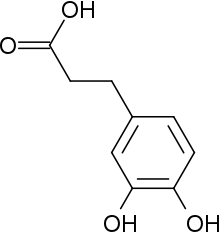Dihydrocaffeic acid
3(3,4-dihydroxy-phenyl) propionic acid commonly referred to as dihydrocaffeic acid or DHCA[1] is a phytochemical found in grapes and other plants. DHCA is known to lower IL-6 production through down regulation of DNMT1 expression and inhibition of DNA methylation of the IL-6 gene in mice. DHCA in combination with malvidin-3′-O-glucoside (Mal-gluc), is effective in promoting resilience against stress by modulating brain synaptic plasticity and peripheral inflammation. DHCA/Mal-gluc also significantly lowered depression like phenotypes in mice that had increased peripheral inflammation caused by transplantation of hematopoietic progenitor cells from other more stress-susceptible mice.[2]
 | |
| Names | |
|---|---|
| Preferred IUPAC name
3-(3,4-Dihydroxyphenyl)propanoic acid | |
| Identifiers | |
3D model (JSmol) |
|
| 3DMet | |
| 2213449 | |
| ChEBI | |
| ChEMBL | |
| ChemSpider | |
| ECHA InfoCard | 100.012.804 |
| EC Number |
|
| 482169 | |
| KEGG | |
PubChem CID |
|
| UNII | |
CompTox Dashboard (EPA) |
|
| |
| |
| Properties | |
| C9H10O4 | |
| Melting point | 136 °C (277 °F; 409 K) |
| 42.8 g/L | |
| Hazards | |
| GHS labelling: | |
 | |
| Warning | |
| H315, H319, H335 | |
| P261, P264, P271, P280, P302+P352, P304+P340, P305+P351+P338, P312, P321, P332+P313, P337+P313, P362, P403+P233, P405, P501 | |
Except where otherwise noted, data are given for materials in their standard state (at 25 °C [77 °F], 100 kPa).
Infobox references | |
References
- PubChem. "3-(3,4-Dihydroxyphenyl)propionic acid". pubchem.ncbi.nlm.nih.gov. Retrieved 2019-12-13.
- Wang, Jun; Hodes, Georgia E.; Zhang, Hongxing; Zhang, Song; Zhao, Wei; Golden, Sam A.; Bi, Weina; Menard, Caroline; Kana, Veronika; Leboeuf, Marylene; Xie, Marc (2018-02-02). "Epigenetic modulation of inflammation and synaptic plasticity promotes resilience against stress in mice". Nature Communications. 9 (1): 477. doi:10.1038/s41467-017-02794-5. ISSN 2041-1723. PMC 5797143. PMID 29396460.
 Material was copied from this source, which is available under a Creative Commons Attribution 4.0 International License.
Material was copied from this source, which is available under a Creative Commons Attribution 4.0 International License.
This article is issued from Wikipedia. The text is licensed under Creative Commons - Attribution - Sharealike. Additional terms may apply for the media files.